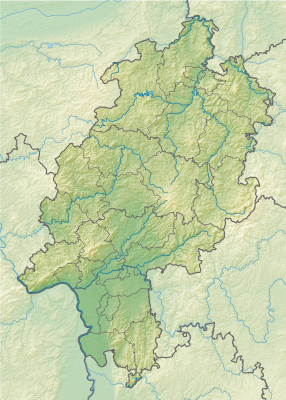Bischhausen Castle (Neuental)
| Bischhausen Castle | ||
|---|---|---|
|
The church in Bischhausen |
||
| Creation time : | 12th Century | |
| Castle type : | Niederungsburg | |
| Standing position : | Local nobility | |
| Place: | Bischhausen | |
| Geographical location | 51 ° 0 '39.8 " N , 9 ° 12' 21.4" E | |
| Height: | 202 m above sea level NN | |
|
|
||
The castle Bischhausen , it is assumed, was a small moated castle or a permanent house or a fortified bower in Bischhausen , a district of the community Neuental in the Schwalm-Eder district in northern Hesse . The elevation on which today's village church stands is regarded as a remnant of this complex.
Geographical location
The facility was located in the eastern end of Bischhausen, immediately west of the Schwalm . There today the road leads to Zimmerrode over the Schwalm, which is dammed by a weir immediately north of the bridge , which supplies the former Schwalmmühle, now used as a hydroelectric power station, with water. On the southern side of the street, on a slight elevation, stands the evangelical church of the village, presumably on the site of the former aristocratic residence, from and on the remains of which the small church was built.
history
The village of Bischhausen is first mentioned in a document in 1160 as "Biscopehusen", the residence of Wernher de Biscopeshusun , the progenitor of the noble family of Löwenstein in northern Hesse , who then moved from Bischhausen to the Ortberg near Oberurff-Schiffelborn , which is about 4 km north-west, today District of Bad Zwesten , relocated. His grandson Wernher II von Bischofshausen, during the Thuringian-Hessian War of Succession (1247–1264) at times district judge and governor for Sophie von Brabant and her son Heinrich I in Hesse, built there in place of the family seat established by his grandfather, which was first documented in 1253 Löwenstein Castle .
The move to the Ortberg was followed by the final abandonment at the beginning of the 13th century and as a result, accompanied by the gradual transfer of the Löwenstein property in Bischhausen to the Haina monastery , the neglect and the decline of the previous residence in Bischhausen. The Heimatverein Bischhausen is of the opinion that it was a three-story fixed house with a moat, and has set up a corresponding model for the 850th anniversary on the traffic island in the west of the village. However, none of the deed of donation mentions a castle, bower or other type of dwelling, which on the one hand raised doubts about the existence of such, but on the other hand it can be explained by the fact that the residential complex was already largely neglected and thus rather worthless.
What is certain is that in the 15th century a late Gothic fortified church with a fortified churchyard was built on the elevation on the Schwalmufer, and it is assumed that the walling of the churchyard was at least partially built with stones from the earlier system. The large stone slabs and stones found at a shallow depth in the part of the former churchyard, which is now used as a garden, are interpreted as the ruins of the old aristocratic residence. Stones from there were still being used in 1859 for the new construction of the Schwalm Bridge.
Of this church, only the former defensive tower with loopholes , today the stair tower , on the northeast side of the apse and the apse itself with its three-sixth end remain, although the latter has only concrete traces of the construction period on the base and eaves can be recognized. The western half of the church was not added until 1742.
literature
- Felix von und zu Gilsa: Traces of the Thalburg Werner von Bischoffshausen zu Bischhausen an der Schwalm? In: Communications to the members of the Association for Hessian History and Regional Studies , 1899, pp. 85–87
- Werner Ide: Between Adorf and Zwesten , Bernecker, Melsungen, 1972, pp. 37–40
- Friedrich Schunder: The von Loewenstein - history of a Hessian family (3 volumes), graph. Large company Lübecker Nachrichten, Lübeck, 1955
Web links
- Bischhausen, Schwalm-Eder district. Historical local dictionary for Hessen. In: Landesgeschichtliches Informationssystem Hessen (LAGIS).
Footnotes
- ↑ Larger donations to the monastery are reported in the years 1262, 1280, 1300 and 1311. (Friedrich Schunder: Die von Loewenstein, History of a Hessian Family (3 volumes), Graph. Grossbetrieb Lübecker Nachrichten, Lübeck, 1955, Volume 2, Regest No. 34 (p. 28); and Bischhausen, Schwalm-Eder-Kreis. Historical Local lexicon for Hessen. In: Landesgeschichtliches Informationssystem Hessen (LAGIS).)
- ↑ beginning , on neuental-bischhausen.de
- ↑ a b Felix von und zu Gilsa: Traces of the Thalburg Werner von Bischoffshausen zu Bischhausen an der Schwalm? In: Communications to the members of the Association for Hessian History and Regional Studies, 1899, pp. 85–87
- ↑ Werner Ide: From Adorf to Zwesten. Local history pocket book for the Fritzlar-Homberg district. Bernecker Verlag, Melsungen, 1972, p. 38
- ↑ Felix von und zu Gilsa: Traces of the Thalburg Werner von Bischoffshausen zu Bischhausen an der Schwalm? In: Communications to the members of the Association for Hessian History and Regional Studies, 1899, pp. 85–87
- ^ Rudolf Knappe: Medieval castles in Hessen. 800 castles, castle ruins and fortifications. 3. Edition. Wartberg-Verlag, Gudensberg-Gleichen 2000, ISBN 3-86134-228-6 , pp. 87-88.



